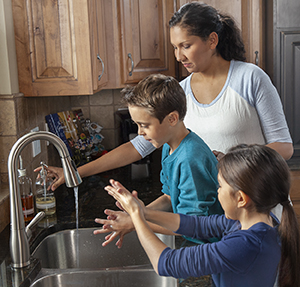Understanding the Cold Virus
Colds are one of the most common illnesses that people get. Most adults get 2 or 3 colds per year, and most children get even more. Colds may be caused by over 200 types of viruses. The most common of these are rhinoviruses (“rhino” refers to the nose).
What causes a cold virus?
All colds start with infection by a virus. You can be infected by more than one cold virus at a time. Colds and flu are respiratory illnesses, but they are caused by different viruses. Infection with cold viruses happens when:
-
You breathe in a virus from the air. This can happen when someone with a cold sneezes or coughs near you.
-
You touch your eyes, nose, or mouth when your hand has a cold virus on it. This can happen if you touch an object that has the cold virus on it.
What are the symptoms of a cold virus?
You may wonder if you have a cold or the flu. Compared to the flu, cold symptoms come on more gradually. Almost all colds cause a stuffy nose. Other common cold symptoms include:
-
Runny nose
-
Sneezing
-
Sore throat
-
Cough
-
Fatigue (sometimes)
-
Fever (rare)
-
Headache (rare)
How is a cold treated?
Colds usually last 7 to 10 days. Treatment focuses on relieving symptoms. Treatments may include:
-
Decongestant medicines. Several types of decongestants are available without prescription. These may help reduce stuffy or runny nose symptoms.
-
Prescription or over-the-counter nasal sprays. These may help reduce nasal symptoms, including stuffiness.
-
Over-the-counter (OTC) pain medicines. These can help with headaches and sore throat.
-
Self-care. This includes extra rest, using humidifiers, and drinking more fluids. These help you feel better while you are getting over a cold.
Because viruses cause colds, antibiotics don't help. They don't make a cold shorter or relieve symptoms. Taking antibiotics when you don’t need them can make them work less well when you need them for another illness.
Follow all directions for using medicines, especially when giving them to children. Contact your healthcare provider if you have any questions about using cold medicines safely. Before buying cold medicines, make a list of any prescription medicines you take and ask the pharmacist what OTC cold medicines are safe for you to use.
Can a cold be prevented?
You can help reduce the spread of cold viruses. This can help both you and others avoid getting colds. Follow these tips:
-
Wash your hands often with soap and clean running water. Wash your hands for at least 20 seconds. When you can’t wash with soap and water, use a hand sanitizer that contains at least 60% alcohol.
-
Don’t touch your nose, eyes, or mouth, especially after touching something that may have a cold virus on it.
-
Cover your mouth and nose when you cough or sneeze. Throw away tissues after using them and wash your hands.
-
Disinfect things you touch often, such as phones and keyboards.
-
Stay home when you have a cold.
-
Consider wearing a mask with 2 or more layers of washable, breathable fabric. A mask may lower your risk of getting respiratory viruses of many kinds. Make sure the mask fits snugly against your face and completely covers your nose and mouth and Use this when near others, to prevent COVID-19 and other respiratory viruses.
 |
| Washing hands often helps reduce the risk of spreading cold viruses. |
What are possible complications of a cold virus?
Colds usually go away by themselves. But you may get another type of infection while you have a cold. These can include:
If you have asthma or chronic bronchitis, a cold can make your condition worse.
When should I call my healthcare provider?
Call your healthcare provider or seek medical care right away if you have any of these:
-
Fever of 100.4°F (38°C) or higher, or as directed by your healthcare provider
-
Cough, chest pain, or shortness of breath that gets worse
-
Symptoms don’t get better or get worse after about 10 days
-
Headache, sleepiness, or confusion that gets worse
Online Medical Reviewer:
Barry Zingman MD
Online Medical Reviewer:
L Renee Watson MSN RN
Online Medical Reviewer:
Rita Sather RN
Date Last Reviewed:
1/1/2022
© 2000-2024 The StayWell Company, LLC. All rights reserved. This information is not intended as a substitute for professional medical care. Always follow your healthcare professional's instructions.